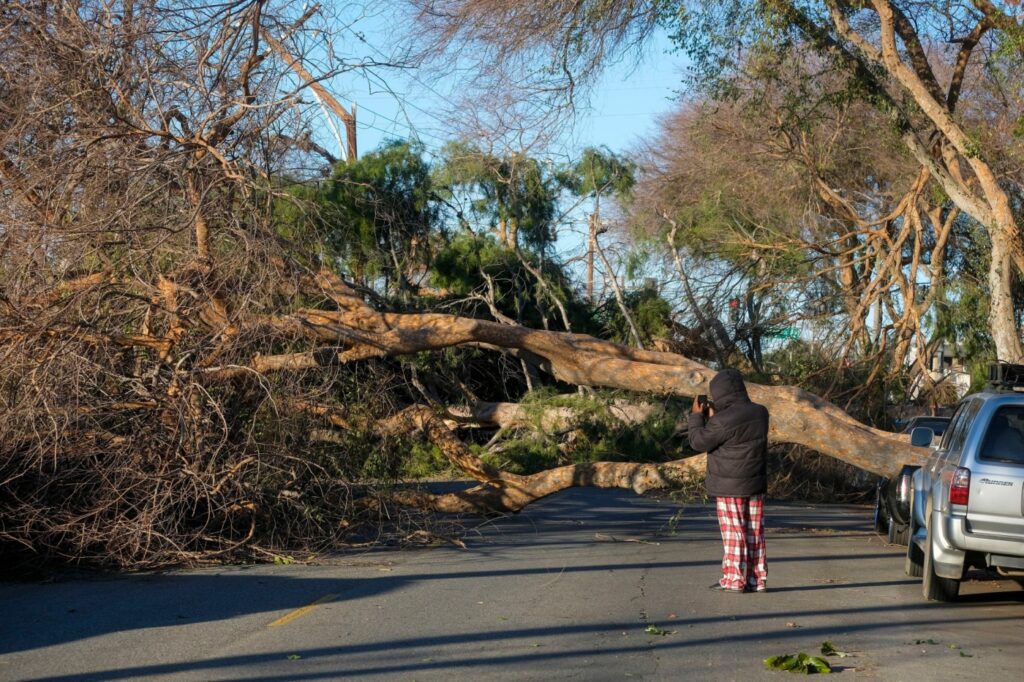
Q: The trees in Claremont were ravaged by the wind storm in January, which left large oaks and pines blown down. If trees did survive, many were stripped of leaves, especially on the north side where the winds came from. Citrus, which are not deciduous and therefore were in leaf, were buffeted; my grapefruit, lime and avocados now have many stems without leaves. How can we help these trees recover? What should we be doing for the rest of the garden after the winds? Should we do anything in anticipation of future windstorms?
A: The powerful windstorms that we experience in Southern California are rough on our trees. Hot, dry air will dry out everything it touches, and the occasional 70 mph gusts can topple even well-established trees.
To protect young trees, it’s important to establish a strong root system. Water deeply and slowly, starting about two feet from the trunk. As the tree grows, move the irrigation further from the tree to encourage the roots to spread outward. For mature trees, place a soaker hose along the dripline (under the edge of the tree’s canopy).
Related links
How to fertilize trees after mulching and tips for old wood chips
What to know about pruning and trimming garden plants and trees in the fall and winter
How to protect your trees from strong winds
Avoid planting boxed trees because the roots will invariably be stunted. When a tree is grown in a container, the roots will grow outward until they reach the inside wall of the pot or box. Once this happens, they will begin to grow in a circular path and eventually take the shape of the container. Planting a tree from a 5-gallon pot is not as satisfying at first, but that tree is more likely to survive a windstorm.
Proper staking is helpful for newly planted trees. Place the stakes about 2 feet away from the trunk and position them so that they are lined up perpendicular to the prevailing wind direction. Place the ties about 2/3 of the way up the tree (so, if you have a 9 or 10 foot tree, the ties should be about 6 feet from the ground). Tie the tree loosely enough to allow for some back-and-forth motion. This causes the trunk to grow strong enough to eventually remove the stakes. Don’t leave the stakes for more than a few years. I have seen staked trees that have grown large enough to lift the stakes out of the ground. If the trunk is larger than the stakes, it’s time to remove them!
Pruning to thin the canopy can allow wind to flow through the tree. Deciduous trees are easier to prune during the winter, for obvious reasons. Citrus can be pruned after harvesting. Usually citrus doesn’t require much pruning—just remove dead branches and suckers. In windy areas, you may want to prune for height reduction as well. Never, ever “top” a tree!
For trees that have defoliated from wind damage, keep them watered and remember to apply fertilizer in the spring when the leaves start growing back. If a grafted tree breaks at the graft site, it should be replaced.
Have questions? Email gardening@scng.com.
Looking for more gardening tips? Here’s how to contact the Master Gardener program in your area.
Los Angeles County
mglosangeleshelpline@ucdavis.edu; 626-586-1988; http://celosangeles.ucanr.edu/UC_Master_Gardener_Program/
Orange County
ucceocmghotline@ucanr.edu; 949-809-9760; http://mgorange.ucanr.edu/
Riverside County
anrmgriverside@ucanr.edu; 951-683-6491 ext. 231; https://ucanr.edu/sites/RiversideMG/
San Bernardino County
mgsanbern@ucanr.edu; 909-387-2182; http://mgsb.ucanr.edu/
Related Articles
How this highly irregular species has thrived in Southern California
Diagnosing why an avocado tree’s fruit is shaped like small hot dogs
This edible plant almost went extinct 500 years ago. Now it grows well everywhere
How to treat leaf curl on a peach tree
Why this fruit-bearing California native plant is great for your garden
